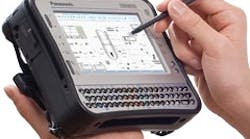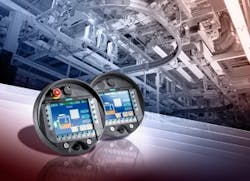How do the process industries view wireless technologies? A newly published report, "The State of Industrial Wireless," from application provider Apprion, Mountain View, Calif., provides a perspective gleaned from eight surveys the company conducted over the past year.
The report notes:
• Sixty-four percent of facilities surveyed have at least one wireless application installed;
• from April 2009 to April 2010 wireless adoption increased 23% and sites currently considering wireless applications grew by 85%;
• condition monitoring/asset management applications lead wireless adoption in 2009 with an increase of 56%;
• video, communications and mobility are the applications driving the next wave of adoption;
• workforce productivity and compliance with safety and security are key drivers for adoption; and
• cost/budget constraints represent the number one barrier to implementing wireless applications.
The report reckons that as the economic climate improves so, too, will wireless adoption.
More facilities now are tying together mobility and real-time data, notes Warren Smith, Apprion's new vice president of products. "Visionaries like Huntsman Chemical and Chevron are realizing the value of moving to a wireless infrastructure and the importance of getting real-time data to mobile workers — something you cannot do with fixed devices and wires. It's about getting the right information in people's hands quickly and in real-time. Real-time data and wireless mobility greatly enhances facilities' safety and security," he says.
Project Zero
Huntsman began an initiative — dubbed Project Zero — at its Port Neches, Texas, site in mid-2008. This required a completely mobile solution to empower operations and maintenance personnel to capture defects, track work progress and make process- and safety-related decisions in real-time. The company partnered with Apprion, software maker Industrial Mobility, The Woodlands, Texas, and Motorola, Schaumburg, Ill.
As part of the initiative, the site installed 91 IONizer multi-radio multi-protocol access points from Apprion to allow gathering critical data anywhere and at any time. With future developments in mind, the network also was enabled with VoIP capabilities and made scalable.
Huntsman used RFID technology to identify individual equipment in the field. A passive RFID tag enables a field worker to locate each piece of equipment in the database as well as all documentation about it simply by using the Motorola MC9090 handheld to scan the RFID tag.
The system went live in May 2009. It now covers more than 70% of the plant, with 100% coverage expected by the end of this summer.
It has increased the number of defects captured and reduced redundant efforts. For example, operations staff have identified those pieces of equipment that fail more frequently than others — these now are prioritized and get more frequent checks, while those found to be more reliable get fewer checks.
The next step in the program includes a Six Sigma study together with expansion to other plants and plans for deployment of additional wireless applications.
Meanwhile, BASF, Ludwigshafen, Germany, began a project to expand mobile maintenance solutions in its production plants at the start of this year, notes Christiane Cloos of its Communications Engineering & Maintenance department. "Up to now the market is mainly dominated by single solutions, but there are only few standardized and certifiable offers with optimized and flexible gateways to SAP. Furthermore, very few handhelds are available for explosion-hazard areas. As a result, we will develop a plan for our specific requirements in the coming months. Realization is planned for 2011."
Tough Tablet
Emerson Process Management, Austin, Texas, also is pushing ahead with wireless developments. The company currently is working with Panasonic, Secaucus, N.J.
Essentially Panasonic has leveraged the Intel Atom processor platform to create the Toughbook U1, a rugged hazardous-area-rated tablet PC, that's powerful enough to run the DeltaV digital automation system and other applications, including DeltaV Remote Operator Station, Ovation Expert Control System and Syncade Operations Management (Figure 1). "All you need is a wireless connection. Most of our customers are trying the U1 out; we have installed a number of hotspots on their sites and they are evaluating how well they work," explains Neil Peterson, marketing manager for Wireless Services.
One unnamed customer is doing an extensive review at a trial site to test everything before making recommendations about using U1 company-wide. "And it's not just Emerson's technology either — a lot of other company's solutions are being trialed too. But absolutely everything comes into the review, for example, video security, mobile worker security — and all the different permutations that might affect site security," he notes.
Concerns about security aren't derailing wireless adoption, he says. "Today we are very secure and, at Emerson, we promote 'defense in depth.' Even so, everyone is taking their time and being appropriately cautious. Fewer concerns surround the Global Wireless IEC approved 62591standard (WirelessHART) as it has been vetted by independent testing facilities (NAMUR) and there are only devices — not people — communicating on the network." [For more on WirelessHART, see "Make the Most of WirelessHART."]
The latest version (v10) of DeltaV has been modified so that the Delta Operate application fits on the U1 screen. "This is a small — 1,000 × 600 pixels — a small amount of real estate on which to display a lot of information. However, it is four times the size of a PDA display. This is very different from a control room where an operator may have a large 20-in. monitor to display a big picture view of the operation," explains Peterson. "We can take that screen and quickly break it into four separate screens for the handheld. This allows the same operator to get up from his desk, pick up the U1, and 'pan and scan' through the larger view on the handheld while walking around."
Peterson believes a turning point is coming for mobile workers. "This could come from Wireless N, the next generation in wireless technology. This has up to 12 times the speed and nearly twice the range of the preceding Wireless G standard. Signal reflectivity (MIMO) is a big boon with this technology, too — something that we can definitely take advantage of, bearing in mind all the metal that is present in process plants. All we need now is for Wi-Fi network providers to release equipment rated for use in hazardous zones."
The future, he says, is obvious: tablets that are lighter, thinner and with a bigger screen — like an iPad. "I think that a process-hardened iPad will become a reality. Then eventually we could have augmented reality where you could simply hold up the tablet anywhere in the process unit and instantly access all the process, diagnostics, etc., information that you need based on where you were standing and looking. We've pretty much achieved that now, but it's not 'Apple-sexy' yet."
Extensible System
The latest wireless development from Invensys Operations Management, Plano, Texas, came in early May when the company launched the latest version of its Wonderware IntelaTrac mobile workforce-management and decision-support system.
"Its extensibility enables our clients and ecosystem partners to integrate a number of systems throughout the plant with an IntelaTrac mobile device, delivering tasks directly to mobile operators and making them more effective and efficient," says Jim Frider, mobile solutions product marketing manager. "These capabilities help close the information gap that many mobile systems have and deliver useful information directly to the people that need it the most."
Chevron already is benefitting. In February Invensys won a contract to supply the company with IntelaTrac (Figure 2). "Chevron wants a mobile platform capable of supporting many business work processes and an 'out of the box' solution," notes Eric Moorehead, North America client care executive program leader. "Our IntelaTrac solution has been used by Chevron in its downstream business process for several years. By extending the availability of IntelaTrac, Chevron anticipates being able to support many new business processes using a single mobile platform for operations, maintenance, reliability tracking, production data collection and safety inspections across the enterprise."
IntelaTrac will assist operators, field engineers, technicians and supervisors in creating inspection and regulatory procedures. It also will assign, schedule and execute rounds and report findings that are prioritized based on the level of severity of the issue. IntelaTrac enables creating and defining procedures based on best practices, as well as regulatory compliance rules and regulations. Such procedures are re-usable across many operator and technician rounds to ensure that inspections are performed on a routine basis as mandated by overall corporate policies as well as regulations.
Harnessing Handhelds
Honeywell Process Solutions, Phoenix, announced in April that Woongjin Polysilicon will use its Mobile Station technology as well as Experion Process Knowledge System and Foundation Fieldbus at a 5,000-ton/yr. polysilicon plant being constructed in Sangju, South Korea. Mobile Station is designed to increase worker productivity by enabling operators to use a wireless tablet or other handheld device to access critical process information, historical data, graphics and other key functions in the field.
The need for reliability is magnified for corporations such as Woongjin Polysilicon that aim to become global manufacturing leaders," says H. Han, domestic sales leader, Honeywell Korea. "The solution Honeywell is providing Woongjin addresses this issue by delivering the most-relevant information to operators controlling the processes, maximizing the productivity of the workers in the field and promoting overall safety. Having those critical factors in place will allow plant personnel to focus on maintaining high-quality production levels."
That same month, Siemens Industry Automation & Drive Technologies, Munich, Germany, and Alpharetta, Ga., announced that it had improved the performance and hardware of its portable devices for wireless operator control and monitoring of machinery and plants, and enhanced them with additional functions.
The 277F IWLAN Mobile Panel for safety-oriented applications communicates via an access procedure known as "rapid roaming." This ensures fast handover of radio signals between access points and interruption-free roaming times — which is crucial to make certain that the mobile device can perform safety-related actions at all times (Figure 3).
Also in April, Techs4Biz Corp., Hauppauge, N.Y., a provider of software products for managing field activities, announced enhancements to Pervidi's W3, including support for any browser-enabled device including iPhones, Blackberries, iPads and mobile phones. Pervidi W3 includes the ability to record electronic inspections, audits, site surveys, work orders and field activities using any browser-enabled device, dramatically expanding the range of products available to field service personnel for performing their activities and electronically recording results.
In addition to real-time access to information, Pervidi W3 enables managers and supervisors to reassign work to other field technicians, verify status of inspections and work orders, and ensure that activities are performed on time.
Meanwhile, Syclo, Hoffman Estates, Ill., announced in March that its SMART Work Manager and SMART Service Manager applications now are SAP-certified for enterprise support. Syclo's applications connect to the SAP global support backbone and have built-in support for incident processing and remote diagnostics using the partner edition of SAP Solution Manager, providing end-to-end incident management processes.
German utility RheinEnergie, Cologne, aims to take advantage of SMART Work Manager to automate technicians' daily meter and preventative maintenance work-order processes. ENERGY4U, Mannhein, Germany, is implementing the project.
"When ENERGY4U explained SAP was now collaborating with Syclo on the co-innovation of mobile solutions, we were very intrigued, but after learning the SMART Work Manager application worked on both laptops and PDAs, synchronized to SAP ERP without issue, came with a flexible mobile architecture, and required little effort to support it, we were sold," says a RheinEnergie spokeswoman. "Syclo, in cooperation with SAP, provides a low-risk choice to facilitate the exchange of data between our remote workforce and our enterprise implementation of SAP ERP."





